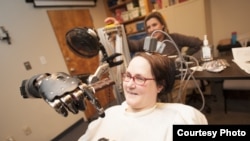A woman paralyzed from the neck down has learned to use her thoughts to manipulate a specially-designed motorized arm. The sophisticated device is the fruit of years of research on mind-controlled artificial limbs, and researchers say the new arm is just the first of a new generation of such prosthetics.
Researchers at the University of Pittsburgh say the prosthetic arm is the most advanced mind-controlled prosthetic ever built. They created the robotic limb -- which they call Hector -- to restore some motor control to a woman suffering from a degenerative neuromuscular disease that has left her paralyzed below the neck. The motorized right arm, with its five-fingered and fully-jointed hand, allows the woman to pick up and hold objects, and to feed herself. The arm movement is driven solely by electrical impulses from the woman's brain.
Watch UMPC video demonstrating 'Hector' in action
Neurobiologist Andrew Schwartz, who led the research team, says scientists implanted about 200 electrodes in the woman’s left cerebral cortex, the part of the brain associated with right arm movement. The electrodes, implanted in February, recorded so-called action potentials from individual neurons or brain cells.
“And that was enough to then decode from those recordings what the intention of the subject was, the way she wanted to move her arm and her wrist and close her hand. We could decode the information from those neurons to allow us to do that,” Schwartz explained.
The woman, Jan Scheuermann, took part in a 13-week training program to teach her brain to manipulate the sophisticated prosthetic. She was a quick study, using her mind to move the robotic limb freely after just two weeks.
Scheuermann reportedly told researchers that she planned to use Hector to feed herself some chocolate. She finally did, sparking excitement and applause from the research team.
Team leader Andrew Schwartz says he and his colleagues plan to develop a second artificial arm for patients like Scheuermann so they can more effectively hold and manipulate objects, using two hands. “And really the satisfying part is that we’re not just making a machine move. We’re actually recreating natural humanoid movements," he noted. "So we’re capturing all the beauty and grace and skill of a real movement, allowing these subjects to basically return to a certain amount of function that they used to have.”
Researchers would also like to create a wireless brain-machine interface system, converting neuronal impulses into computer signals, for people to use independently in their homes without wires or the supervision of scientists.
An article by the University of Pittsburgh’s Andrew Schwartz and colleagues describing the prosthetic arm named Hector is published in the journal The Lancet.
Researchers at the University of Pittsburgh say the prosthetic arm is the most advanced mind-controlled prosthetic ever built. They created the robotic limb -- which they call Hector -- to restore some motor control to a woman suffering from a degenerative neuromuscular disease that has left her paralyzed below the neck. The motorized right arm, with its five-fingered and fully-jointed hand, allows the woman to pick up and hold objects, and to feed herself. The arm movement is driven solely by electrical impulses from the woman's brain.
Watch UMPC video demonstrating 'Hector' in action
Neurobiologist Andrew Schwartz, who led the research team, says scientists implanted about 200 electrodes in the woman’s left cerebral cortex, the part of the brain associated with right arm movement. The electrodes, implanted in February, recorded so-called action potentials from individual neurons or brain cells.
“And that was enough to then decode from those recordings what the intention of the subject was, the way she wanted to move her arm and her wrist and close her hand. We could decode the information from those neurons to allow us to do that,” Schwartz explained.
The woman, Jan Scheuermann, took part in a 13-week training program to teach her brain to manipulate the sophisticated prosthetic. She was a quick study, using her mind to move the robotic limb freely after just two weeks.
Scheuermann reportedly told researchers that she planned to use Hector to feed herself some chocolate. She finally did, sparking excitement and applause from the research team.
Team leader Andrew Schwartz says he and his colleagues plan to develop a second artificial arm for patients like Scheuermann so they can more effectively hold and manipulate objects, using two hands. “And really the satisfying part is that we’re not just making a machine move. We’re actually recreating natural humanoid movements," he noted. "So we’re capturing all the beauty and grace and skill of a real movement, allowing these subjects to basically return to a certain amount of function that they used to have.”
Researchers would also like to create a wireless brain-machine interface system, converting neuronal impulses into computer signals, for people to use independently in their homes without wires or the supervision of scientists.
An article by the University of Pittsburgh’s Andrew Schwartz and colleagues describing the prosthetic arm named Hector is published in the journal The Lancet.






